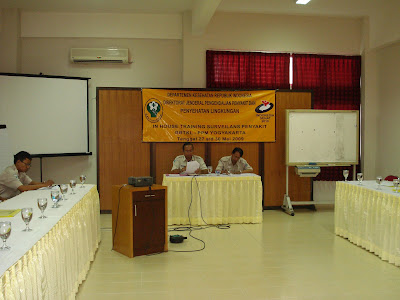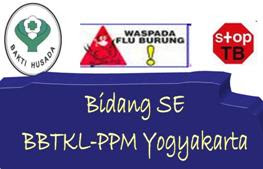



Surveilans adalah pengamatan terus-menerus terhadap terjadinya dan penyebaran penyakit serta kejadian/kondisi yang memperbesar risiko penyebaran penyakit. Surveilans epidemiologi adalah serangkaian kegiatan yang teratur dan terus menerus dimulai dari:pengumpulan, pengolahan, penyajian dan analisis data serta penyebarluasan informasi untuk penentuan tindakan.
Beban ganda penyakit menular saat ini tidak hanya meliputi penyakit-penyakit yang tergolong dalam New dan Re-emerging Disease tetapi juga Emerging Disease yang masih belum tuntas penanggulangannya. Kejadian sakit tidak semata-mata karena daya tahan tubuh dan kerentanan terhadap kuman penyebab penyakit tetapi ada factor risiko yang mempengaruhi, baik perilaku maupun lingkungan. Faktor risiko biasanya tidak berdiri sendiri tetapi bersifat multi factorial. BBTKL-PPM Yogyakarta mempunyai peran dalam deteksi dini dan intervensi terhadap factor risiko kejadian penyakit melalui surveilans factor risiko.
Tujuan yang ingin dicapai adalah meningkatkan pengetahuan, kemampuan tentang penyakit menular dan faktor risikonya, meningkatkan kemampuan dalam melaksanakan surveilans faktor risiko, dan meningkatkan kemampuan untuk deteksi dini bagi sumber daya manusia di BBTKL-PPM Yogyakarta.
Kegiatan ini diselenggarakan pada tanggal 27 – 30 Mei 2009 di Hotel University Sunan Kalijaga Yogyakarta sebagai peserta adalah pegawai BBTKL-PPM Yogyakarta berjumlah 30 orang yang terdiri dari para praktisi laboratorium dan tenaga fungsional yang mempunyai dasar pendidikan yang bervariasi. Dari Bidang Surveilans Epidemiologi sebanyak 4 orang, Bidang PTL sebanyak 24 orang, dan dari Bagian Tata Usaha sebanyak 2 orang.
Materi In House Training berjumlah 32 Jam Pelajaran (JPL), dengan masing-masing JPL berdurasi 45 menit. Materi tersebut terdiri dari :
1. Materi Dasar:
a. Kebijakan Program Surveilans Epidemiologi (DR. Hari Santoso, SKM, M.Epid – Kadit SEPIM Kesma Ditjen PP&PL Depkes RI, 2 JPL)
b. Kebijakan Program P2MK Dinas Kesehatan Propinsi Jateng (Dr. Djoko Mardijanto, M.Kes – Ka. Bid P2PL Dinkes Prop. Jateng, 2 JPL)
c. Kebijakan Program P2MK Dinas Kesehatan Propinsi DIY (Rubiyo, SKM, M.Si – Staf Sie Surveilans & Imunisasi Dinkes Prop. DIY, 2 JPL)
2. Materi Inti:
a. Dasar-dasar Epidemiologi (dr.Rossi Sanusi,MPA.PhD – Dosen FETP Prodi Kesehatan Masyarakat FK UGM, 2 JPL)
b. Dasar-dasar Surveilans Epidemiologi (dr.Haripurnomo Kushadiwijaya.,MPH.,DrPH – Dosen FETP Prodi Kesehatan Masyarakat FK UGM, 2 JPL)
c. Sistem Kewaspadaan Dini dr. Haripurnomo Kushadiwijaya.,MPH.,DrPH – Dosen FETP Prodi Kesehatan Masyarakat FK UGM, 4 JPL)
d. Metode Penelitian Epidemiologi (Drg. Dibyo Pramono, SU, MDSc - Dosen FETP Prodi Kesehatan Masyarakat FK UGM, 2 JPL)
e. Penyelidikan dan Penanggulangan KLB (dr.Haripurnomo Kushadiwijaya.,MPH.,DrPH – Dosen FETP Prodi Kesehatan Masyarakat FK UGM, 4 JPL)
f. Surveilans Faktor Risiko (dr.Rossi Sanusi,MPA.PhD – Dosen FETP Prodi Kesehatan Masyarakat FK UGM, 2 JPL)
g. Surveilans Berbasis Laboratorium (Dr.Andajani Woerjandari,M.Kes. – Ka. BP4 Prop. DIY, 2 JPL)
3. Meteri Pendukung:
a. Praktek Studi Kasus Kejadian KLB (Widyana, SKM, M.Kes – Widya Iswara Bapelkes Kalasan Yogyakarta, 2 JPL)
b. Presentasi Hasil Surveilans Penanganan KLB (Kelompok Peserta, 2 JPL)
Rangkuman hasil In House Training antara lain:
In House Training diisi dengan penyajian materi yang dilanjutkan dengan tanya jawab, diskusi kelompok, dan presentasi hasil diskusi. Secara keseluruhan tingkat respon peserta sangat tinggi yang ditunjukkan dengan antusias peserta dalam mengikuti materi, bertanya kepada narasumber dan diskusi kelompok sesuai dengan studi kasus yang dibebankan.
Dari segi ketertiban dan partisipasi peserta sangat bagus, peserta cukup aktif dalam setiap session materi, tanya jawab dan diskusi. Dari segi kedisplinan peserta cukup bagus, tepat waktu dan semua peserta mengikuti keseluruhan materi seperti yang telah ditentukan. Narasumber selalu tepat waktu, beberapa materi bahkan kekurangan waktu untuk diskusi dan tanya jawab.
Semoga dengan adanya kegiatan In House Training ini dapat menambah wawasan pengetahuan bagi sumber daya manusia di BBTKL PPM Yogyakarta dalam bidang Surveilans Faktor Risiko Penyakit.

